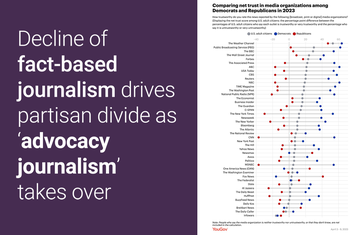
Are we living in a new age of agitprop? It is not unusual for journalism, culture and the arts to reflect the political bias of societies and individual writers. But in the past few decades, the business of providing information and insight has sharply deteriorated. Particularly at the elite level, the media now embrace an increasingly uniform point of view on issues as diverse as gender, race, the pandemic and climate.
To be sure, there still exists a vibrant oppositional press that offers divergent views. Nevertheless, so many mainstream media outlets increasingly resemble something closer to the kind of agitprop perfected by Russian Marxists, Lenin and their heirs. What was once a liberally minded industry, notes Michael Shellenberger, has embraced censorship as the one cure for what it defines as ‘misinformation’.
The results for consumers have been disastrous. In the new media world, all news coverage is geared towards upholding pre-established narratives. Actual reporting has become exceedingly rare. A 2019 report from think-tank Rand revealed that journalism is steadily moving away from a fact-based model and toward one dominated by opinion. The result is what Rand described as ‘truth decay’. This reflects a disappointing turn within a media industry that once proudly opposed existing power structures.
The rise of agitprop in the media is largely a result of increasing geographic, ideological and class uniformity. There has been a drastic change in the composition of the journalistic profession. Working-class reporters, many with ties to local communities, have been replaced by a more cosmopolitan and uniformly ‘progressive’ breed with college degrees. At schools like Columbia, aspiring journalists focus less on the fundamentals of reporting and more on openly advancing a ‘social justice’ agenda.
Many of these younger reporters, notes Pew, do not embrace the old ideas about objectivity and balance. And most tilt overwhelmingly to the ‘progressive’ side of politics. A survey in 2014 found that barely seven per cent of US reporters identified as Republicans. And according to some analyses, in 2018, some 97 per cent of all political donations from journalists went to Democrats.
Similar patterns are found in other Western countries, too. In France, two-thirds of journalists favour the left, notes author Christophe Guilluy, even as voters have swung demonstrably to the right.
In most countries, the political tilt in journalism has been intensified by a geographical concentration of media in fewer centres – especially in London, New York and San Francisco. Meanwhile, local media have struggled in the internet age, preferring to promote a particular party line.
Read the rest of this piece at Spiked.
Joel Kotkin is the author of The Coming of Neo-Feudalism: A Warning to the Global Middle Class. He is the Roger Hobbs Presidential Fellow in Urban Futures at Chapman University and Executive Director for Urban Reform Institute. Learn more at joelkotkin.com and follow him on Twitter @joelkotkin.
Photo credit: chart from YouGov, shared on Reddit.












